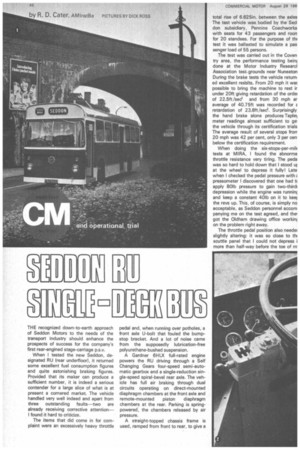THE recognized down-to-earth approach of Seddon Motors to the needs
Page 48

Page 49

If you've noticed an error in this article please click here to report it so we can fix it.
of the transport industry should enhance the prospects of success for the company's first rear-engined stage-carriage p.s.v.
When I tested the new Seddon, designated RU (rear underfloor), it returned some excellent fuel consumption figures and quite astonishing braking figures. Provided that its maker can produce a sufficient number, it is indeed a serious contender for a large slice of what is at present a cornered market. The vehicle handled very well indeed and apart from three outstanding faults---two are already receiving corrective attention I found it hard to criticize.
The items that did come in for complaint were an excessively heavy throttle pedal and, when running over potholes, a front axle U-bolt that fouled the bumpstop bracket. And a lot of noise came from the supposedly lubrication-free polyurethane-bushed suspension.
A Gardner 6HLX full-rated engine powers the RU driving through a Self Changing Gears four-speed semi-automatic gearbox and a single-reduction single-speed spiral-bevel rear axle. The vehicle has full air braking through dual circuits operating on direct-mounted diaphragm chambers at the front axle and remote-mounted piston diaphragm chambers at the rear. Parking is springpowered, the chambers released by air pressure.
A straight-topped chassis frame is used, ramped from front to rear, to give a total rise of 6.625in. between the axles The test vehicle was bodied by the Sed don subsidiary, Pennine Coachworks with seats for 43 passengers and roorr for 20 standees. For the purpose of thi test it was ballasted to simulate a pas senger load of 55 persons.
The test was carried out in the Coven try area, the performance testing beim done at the Motor Industry Researcl Association test-grounds near Nuneaton During the brake tests the vehicle return. ed excellent reSbIts. From 20 mph it was possible to bring the machine to rest ir under 20ft giving retardation of the ordei of 22.5ft/see and from 30 mph ar average of 40.75ft was recorded for C retardation of 23.8ft/see. Surprisingly the hand brake alone produces Taple) meter readings almost sufficient to ge the vehicle through its certification trials The average result of several stops iron' 20 mph was 42 per cent, only 3 per cen below the certification requirement.
When doing the six-stops-per-milt tests at MIRA, I found the abnorma throttle resistance very tiring. The peda was so hard to hold down that I stood Li' at the wheel to depress it fully! Late when I checked the pedal pressure with pressometer I discovered that one had tt apply 80Ib pressure to gain two-third depression while the engine was runnirq and keep a constant 40Ib on it to keel the revs up. This, of course, is simply no acceptable, as Seddon personnel accom panying me on the test agreed, and the, got the Oldham drawing office workinc on the problem right away.
The throttle pedal position also needei slightly altering: it was so close to thi scuttle panel that I could not depress i more than half-way before the toe of rrr shoe came up against the panel. To achieve full depression I had to turn my foot sideways. And the angle of the pedal when on full throttle was far too wide; imagine sitting in a chair with toes pressed to the floor at a pressure of some 40Ib for several hours and one gets a good idea of just what discomfort this arrangement can cause.
Impressive
In most of the recent bus tests I have completed for CM I have commented on the ease and simplicity of gearchanging with the SCG semi-automatic gearbox. Once again I was impressed with just how smooth, yet quick and positive this unit is. The snappiest changes can be made with the minimum of concentration without the ride being jerky or otherwise uncomfortable. Moving-off on gradients with the fluid flywheel is simply a matter of engaging first gear and placing one's foot on the throttle, this resulting in a perfect take-off every time. Changes can be made from any gear to any other gear as desired. Although there is a baulking frame in the selector gate which is supposed to prevent the driver engaging second or first gear without first going through third, in practice one can flick the lever into third and immediately straight into second or first before the mechanism has time to operate and actually engage third.
I took the vehicle over the ride and handling circuit of MIRA. This circuit embodies all the adverse conditions one is ever likely to encounter and a few one is never likely to endure again—in the UK at least. It has adverse cambers, concave road surfaces, ridged surfaces both along the direction of travel and across it, a length of tramline sunk into the road surface, sunken and raised manhole covers, a badly situated level-crossing and in fact all the worst conditions. As far as handling of the RU goes, none of the obstacles encountered seemed to have the least effect on its directional stability.
This vehicle could be driven at a relatively high speed around adverse cambered corners, with 12 to 13 degree of list on the body, without the slightest deviation from one's chosen course. The steering gear was not power-assisted on the test vehicle—although this is optional—and I found sufficient feel in it to permit fine control over the positioning of the vehicle on the road. Neither potholes, sunken manholes nor the tramline had any effect on the vehicle whatever.




































































































